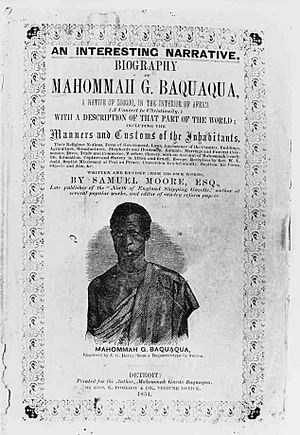Mahommah Gardo Baquaqua facts for kids
Mahommah Gardo Baquaqua was an amazing person who was once enslaved. He was born in West Africa, in a place called Zooggoo, which was part of the Bergoo kingdom. He was taken to Brazil and forced to work there as a captive. But in 1847, he bravely escaped and fled to New York City, where he finally became a free man.
Mahommah could read and write Arabic. He even said a prayer in Arabic for people at New York Central College, where he studied from 1849 to 1853. He wrote a book about his life, called a slave narrative, which was published in 1854. This book is very important because it's the only one we know of written by someone who was enslaved in Brazil.
Contents
Mahommah's Early Life in Africa
Mahommah Gardo Baquaqua was born in a town called Djougou, which is now in the country of Benin. He was born sometime between 1820 and 1830. His family was well-known and involved in trade, and they were Muslim.
As a young boy, Mahommah went to an Islamic school. There, he learned to read the Quran, which is the holy book of Islam. He also studied literature and mathematics.
When he was a teenager, Mahommah and his brother were involved in some local conflicts. These were "succession wars," which means fights over who would become the next leader. During one of these fights in Daboya, Ghana, he was captured, but luckily, he was later rescued.
Capture and Enslavement
After returning to Djougou, Mahommah became a servant for an important local leader, whom he called 'king'. The text mentions he caused some trouble during this time. Because of this, he was caught in a trap and taken prisoner.
In 1845, he was transported to Dahomey, another powerful kingdom. From there, he was forced onto a slave ship. This ship took him across the ocean to Pernambuco in Brazil.
Life as an Enslaved Person in Brazil
Mahommah was enslaved in Olinda, a city in Pernambuco, Brazil, for about two years. His enslaver was a baker. Mahommah had to do hard work, like helping to build houses and carrying heavy stones.
He also learned to speak Portuguese. He worked as an "escravo de tabuleiro," which means a "peddling slave." This job involved selling goods in the streets.
Escape to Freedom
Later, Mahommah was taken to Rio de Janeiro. There, he was made part of the crew on a trading ship called Lembrança, which means "A Memory." This ship carried goods to different parts of southern Brazil.
In 1847, the ship was carrying coffee to the United States. This trip became Mahommah's chance to gain his freedom. The ship arrived in New York Harbor in June. People who were against slavery, called abolitionists, approached the ship. They encouraged Mahommah to escape.
After he escaped, he was unfortunately put in a local jail. But the abolitionists helped him again. They helped him escape from prison, which stopped him from being sent back to the ship. After this, he was sent to Haiti, where he lived with a missionary named Reverend W. L. Judd.
New Life and Autobiography
In 1848, Mahommah became a Christian and was baptized. He returned to the United States because of political problems in Haiti. He then studied at New York Central College in upstate New York for almost three years.
In 1854, he moved to Canada. In the same year, his autobiography, the book about his life, was published in Detroit by Samuel Downing Moore. This book is a very important historical document.
We don't know much about what happened to Mahommah after 1857. At that time, he was in England. He had asked the American Baptist Free Mission Society if he could be sent as a missionary to Africa.
Images for kids



